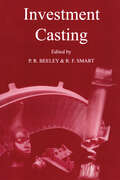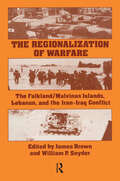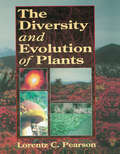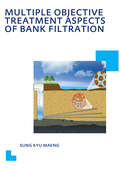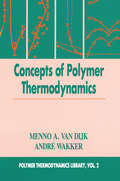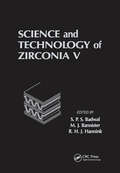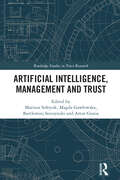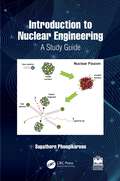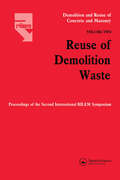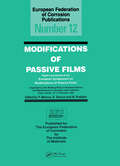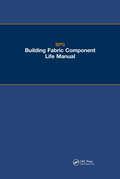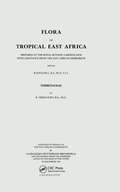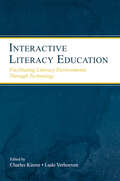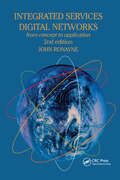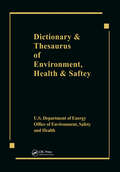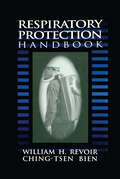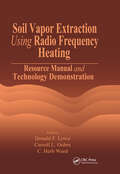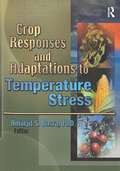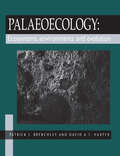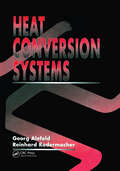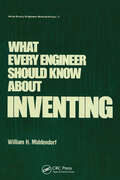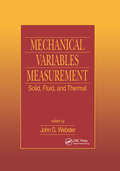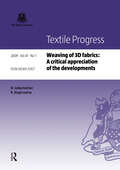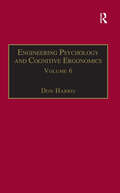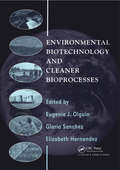- Table View
- List View
Investment Casting
by Philip R. Beeley Robert F. SmartThis modern book on investment casting fills a substantial gap in the literature of metal founding. The investment casting sector of the foundry industry has seen rapid growth; despite this the literature devoted specially to investment casting and its products has remained relatively sparse. Investment Casting has been produced by drawing upon the knowledge of authorities within or closely associated with the industry, in co-operation with the British Investment Casting Trade Association, examining the process and its products in a way which is useful both to the industry and to design engineers. To this end the earlier chapters are devoted to each of the main production stages from tooling to finishing, with health and safety treated separately, commensurate with its current importance.
The Regionalization of Warfare: The Falkland/Malvinas Islands, Lebanon, and the Iran-Iraq Conflict
by James Brown William P. SnyderThree wars have dominated world events in recent years: The conflict which erupted between the United Kingdom and Argentina over the Falkland/Malvinas Islands; the multinational conflict in Lebanon involving Irsaeli, Syrian, and FLO forces in Lebanon; and the savage struggles between ground and air units of the Iranian and Iraqi forces. The scale and intensity of these wars, their potential for global conflict, make them crucial for an understanding among citizens in general, and defense and political analysts in particular.The authors and contributors to this most unusual volume come to several common conclusions: professionalism is a crucial factor in military effectiveness, but not necessarily dependent on modes of recruitment; high technology is crucial, but only in relation to the quality and training of the personnel; public support is necessary to sustain military morale in democratic and authoritarian regimes alike. These are only some of the incisive findings registered and explored in The Regionalization of Warfare.The volume a'ssembles experts not only on these three major regional and interregional conflicts, but on current U.S. defense policies; Soviet strategic interests in Middle East and Persian Gulf conflicts; and a series of papers on lessons learned and unlearned as a result of these "small wars" of the early 1980s. For those interested in military history, global strategy, and regional rivalries, this -collection of finely written, sophisticated papers will prove to be of intense concern.
The Diversity and Evolution of Plants
by Lorentz C. PearsonThis exciting new textbook examines the concepts of evolution as the underlying cause of the rich diversity of life on earth-and our danger of losing that rich diversity. Written as a college textbook, The Diversity and Evolution of Plants introduces the great variety of life during past ages, manifested by the fossil record, using a new natural classification system. It begins in the Proterozoic Era, when bacteria and bluegreen algae first appeared, and continues through the explosions of new marine forms in the Helikian and Hadrynian Periods, land plants in the Devonian, and flowering plants in the Cretaceous. Following an introduction, the three subkingdoms of plants are discussed. Each chapter covers one of the eleven divisions of plants and begins with an interesting vignette of a plant typical of that division. A section on each of the classes within the division follows. Each section describes where the groups of plants are found and their distinguishing features. Discussions in each section include phylogeny and classification, general morphology, and physiology, ecological significance, economic uses, and potential for research. Suggested readings and student exercises are found at the end of each chapter.
Multiple Objective Treatment Aspects of Bank Filtration: Unesco-ihe Phd Thesis
by Sung Kyu MaengBank filtration (BF) is a natural water treatment process which induces surface water to flow in response to a hydraulic gradient through soil/sediment and into a vertical or horizontal well. It is a relatively cost-effective, robust and sustainable technology. From a historical perspective, BF is first mentioned in the bible, and the process has been recognized as a proven method for drinking water treatment in Europe for more than 100 years. However, the mechanisms of removal of different contaminants during BF are not fully understood. This study showed that BF is an effective multiple objective barrier for removal of different contaminants present in surface water sources including bulk organic matter and organic micropollutants (OMPs) like pharmaceutically active compounds and endocrine disrupting compounds. It was found that biodegradation and adsorption play primary and secondary roles, respectively, in the removal of OMPs during soil passage. Furthermore, using field data from BF sites and chemical properties of OMPs, models were developed to estimate the removal of OMPs during soil passage. It can be concluded that the removal efficiencies of BF for these contaminants can be maximised by proper design and operation of recovery wells taking into consideration source water quality characteristics and local hydrogeological conditions.
Concepts in Polymer Thermodynamics, Volume II
by Menno A. van Dijk Andre WakkerThermodynamics is an indispensable tool for developing a large and growing fraction of new polymers and polymer blends. These two volumes show the researcher how thermodynamics can be used to rank polymer pairs in order of immiscibility, including the search for suitable chemical structure of compatibilizers. Because of the great current commercial interest in this most dynamic sector of the polymer industry, there is high interest in studying their physical and mechanical properties, their structures, and the processes of their formation and manufacture. These Books are dedicated to Analysis of the Thermodynamics of Polymer Blends. Thermodynamic behavior of blends determines the compatibility of the components, their morphological features, rheological behavior, and microphase structures. As a result, the most important physical and mechanical characteristics of blends can be identified.
Science and Technology of Zirconia V
by M., BannisterThis book is based on the Fifth International Conference that was held on 16-21 August, 1992 in Melbourne, Australia, in conjunction with AUSTCERAM 92. It demonstrates that the field of Zirconia ceramics remains one of scientific challenge and technical attraction.
Artificial Intelligence, Management and Trust (Routledge Studies in Trust Research)
by Mariusz Sołtysik Magda Gawłowska Bartlomiej Sniezynski Artur GuniaThe main challenge related to the development of artificial intelligence (AI) is to establish harmonious human-AI relations, necessary for the proper use of its potential. AI will eventually transform many businesses and industries; its pace of development is influenced by the lack of trust on the part of society. AI autonomous decision-making is still in its infancy, but use cases are evolving at an ever-faster pace. Over time, AI will be responsible for making more decisions, and those decisions will be of greater importance. The monograph aims to comprehensively describe AI technology in three aspects: organizational, psychological, and technological in the context of the increasingly bold use of this technology in management. Recognizing the differences between trust in people and AI agents and identifying the key psychological factors that determine the development of trust in AI is crucial for the development of modern Industry 4.0 organizations. So far, little is known about trust in human-AI relationships and almost nothing about the psychological mechanisms involved. The monograph will contribute to a better understanding of how trust is built between people and AI agents, what makes AI agents trustworthy, and how their morality is assessed. It will therefore be of interest to researchers, academics, practitioners, and advanced students with an interest in trust research, management of technology and innovation, and organizational management.
Introduction to Nuclear Engineering: A Study Guide
by Supathorn PhongikaroonIntroduction to Nuclear Engineering serves as an accompanying study guide for a complete, introductory single-semester course in nuclear engineering. It is structured for general class use, alongside fundamental nuclear physics and engineering textbooks, and it is equally suited for individual self-study.The book begins with basic modern physics with atomic and nuclear models. It goes on to cover nuclear energetics, radioactivity and decays, and binary nuclear reactions and basic fusion. Exploring basic radiation interactions with matter, the book finishes by discussing nuclear reactor physics, nuclear fuel cycles, and radiation doses and hazard assessment. Each chapter highlights basic concepts, examples, problems with answers, and a final assessment.The book is intended for first-year undergraduate and graduate engineering students taking Nuclear Engineering and Nuclear Energy courses.
Demolition Reuse Conc Mason V2
by Y KasaiThis book includes papers on demolition methods and practice and reuse of demolition waste, presented at RILEM symposium held in Japan. The papers contribute to the development of demolition and reuse of concrete and masonry structures.
Modifications of Passive Films
by P. MarcusThe modification of passive films is a promising method of improving the corrosion resistance of metallic materials. As well as reviewing a wide spectrum of film modifications and their effects on passivity and to corrosion resistance, papers presented at this international symposium deal with chemical composition, chemical states and electronic properties of passive films.
The BPG Building Fabric Component Life Manual
by Building Performance Group Ltd,This manual provides a comprehensive source of building component life-span and maintenance data for commercial and industrial building components, following the same format as the ground-breaking HAPM Component Life Manual for domestic buildings. Each building component is allocated its own data sheet on which a number of generic descriptions are provided together with assessed life-spans and maintenance requirements. References to the relevant standards and codes of practice are also included.
Flora of Tropical East Africa - Verbenaceae (1992)
by B VerdcourtThis book is a comprehensive review of the genera of Verbenaceae, a flowering plant family, found in tropical East Africa. It presents information on their character, occurrence, habitat, phenotypic variations and distribution of each of the species under these genera.
Interactive Literacy Education: Facilitating Literacy Environments Through Technology
by Ludo Verhoeven Charles KinzerInteractive Literacy Education combines the latest research and theory related to technology-based instructional design for children’s literacy development. It shows how technology can be used to build literacy learning environments that are compatible with students’ cognitive and social processes. Topics addressed throughout this enlightening work include:*technology environments and applications that preservice teachers can use with young children;*detailed information regarding the development and implementation of specific technological programs; and*various technologies, from interactive reading and spelling programs to speech recognition to multimedia, that teachers can use to enhance their literacy learning environments. Interactive Literacy Education is intended for graduate courses in methods of literacy instruction; educational technology; curriculum/curriculum design; general preservice education; special education; and applied psychology/cognitive studies. It is also appropriate for use as a supplement in undergraduate courses in methods of literacy instruction and educational technology.
Integrated Services Digital Network: From Concept To Application
by J RonayneAn introduction to "ISDN" which brings the technology up-to-date, incorporating developments in "ATM", "SDH" and Broadband "ISDN". This book is suitable for self-learning communications professionals and applied courses in communications management and technology, and advanced undergraduates and graduates in computing and electronics.
Dictionary & Thesaurus of Environment, Health & Safety
by US Dept of EnergyDictionary & Thesaurus of Environment, Health & Safety is the first and only dictionary/thesaurus to focus on the usage and structure of environment, health, and safety terminology. Containing nearly 600 pages, this book features thousands of terms that may be hard to find in any other reference source. Thesaurus terms are presented under broad subject categories, and all acronyms found in the thesaurus are listed with their reciprocal phrases. A separate section features a mini-thesaurus for Department of Energy vocabulary. ANSI standards were used to construct the thesaurus, and definitions are included for most terms, with acronyms indicating the source(s) of the definitions. Dictionary & Thesaurus of Environment, Health & Safety provides a semantic structure for environment, health, and safety terminology and will prove invaluable for anyone involved in the management of programs and information systems that use these terms.
Respiratory Protection Handbook
by Ching-tsen Bien William H. RevoirFor novices and experienced health and safety professionals alike, the Respiratory Protection Handbook fills a critical gap in the respiratory protection literature. This extensive guide provides all the information you need to dramatically expand your understanding of the concepts and day-to-day operations of respiratory protection. It is a fully self-contained text that expertly accomplishes two goals: first, for the novice, it clearly explains how to establish and implement an effective respiratory protection program; and second, for the experienced professional, it provides in-depth knowledge that goes beyond basics.Respiratory Protection Handbook addresses the development of respiratory protection devices, the capabilities and limitations of specific respirators, the respirator certification system, how to select appropriate filters, how to predict the service life of sorbents, fit testing methods, assigned protection factors, and much more. Nowhere else will you find a single source on this topic containing so much information.
Soil Vapor Extraction Using Radio Frequency Heating: Resource Manual and Technology Demonstration
by C. H. Ward Carroll L. Oubre Donald F. LoweOne of the most widely used techniques for treating soils contaminated with volatile organic compounds, soil vapor extraction (SVE) can also be applied to semi-volatile organic compounds (SVOCs) if the soil is heated, by applying electromagnetic energy in the radio frequency (FR) range, to increase the vapor pressure of the contaminants. Although RF-SVE systems used in previous field demonstrations have had varying degrees of success, questions remain concerning its viability and cost-effectiveness.Soil Vapor Extraction Using Radio Frequency Heating: Resource Manual and Technology Demonstration covers detailed scientific and engineering information that answers these questions. The book includes the necessary databases, equations, and example calculations for RF heating. The theoretical and practical information included will facilitate future testing of RF-SVE treatment of soils. Additionally, the book provides information for a full-scale engineering design of potential RF-SVE applications. The authors use this information to examine predicted performance, magnitude of costs, and modifications to the design that may decrease cost. Soil Vapor Extraction Using Radio Frequency Heating: Resource Manual and Technology Demonstration gives an economic analysis of this innovative technology and considers other possible applications for it.Features
Crop Responses and Adaptations to Temperature Stress: New Insights and Approaches
by Amarjit S. BasraExamine the ways in which various plants respond when exposed to high and low temperatures!The growing demand for food makes breeding for high-yielding crops with built-in resistance against environmental constraints one of the most important challenges for plant breeders today. Crop Responses and Adaptations to Temperature Stress investigates the adaptive mechanisms plants have evolved in response to unfavorable temperature conditions. It describes gene transfer technology and other tolerance improvement techniques that aid in developing stress-tolerant plants.Adverse environmental stress conditions, such as extreme temperatures, affect the productivity of important world food crops by inhibiting plant growth and development. Crop Responses and Adaptations to Temperature Stress provides valuable information on the mechanisms of stress tolerance in plants that encourage growth and enhance yield performance.Agriculture professionals, researchers, and plant breeders will benefit from the ideas shared on such topics as: mechanisms of chilling injury and tolerance injury and acclimation of root system functions during chilling temperatures mechanisms of cold acclimation signal transduction under low-temperature stress mechanisms of thermotolerance in crops control of the heat shock response in crop plants the effects of heat stress on cereal yield and qualityCrop Responses and Adaptations to Temperature Stress presents detailed discussions on the effects and outcomes of crop exposure to low and high temperatures. The textual information is liberally supplemented with visual representations of field experiment data as well as comprehensive tables and schematic drawings.In addition to a detailed review of current knowledge on the molecular biology of plant responses to temperature stress and an introduction to biotechnological advances in improving crop tolerance, Crop Responses and Adaptations to Temperature Stress suggests avenues for further study and speculates on the implications of such work for the future of food production.
Palaeoecology: Ecosystems, Environments and Evolution
by P.J. Brenchley D.A.T HarperThe first palaeoecology book to focus on evolutionary palaeoecology, in both marine and terrestrial environments. Discusses reconstruction of the past ecological world at population, community and biogeographic levels. A well-illustrated and substantial volume giving accessible coverage of the full range of subjects within palaeoecology. Reviews and summarises all the major mass extinctions.
Heat Conversion Systems
by Reinhard Radermacher Georg AlefeldHeat Conversion Systems develops the underlying concepts of advanced Rankine-based absorption and compression cycles and introduces the Building Block Approach as a general concept. The Building Block Approach identifies all cycle configurations for a given application to ensure that system designers have available all important alternatives. The book features numerous examples of advanced cycles and includes single- and multi-stage absorption heat pumps and heat transformers and combined systems. The book also discusses single- and multi-stage vapor compression systems with multiple solution circuits, multiple compressors, and cascades. Aspects of working fluid selection and their influence on cycle options, performance evaluation, and estimating procedures for the Coefficient of Performance (COP) are addressed. Cycle analysis based on the Second Laws of Thermodynamics is examined. Heat Conversion Systems will be an important source for engineers in air-conditioning, heat pumping, refrigeration, and waste heat utilization. It can be used as text in courses on thermodynamics, efficient use of energy, and environmental protection.
What Every Engineer Should Know about Inventing
by William H. MiddendorfThis book provides the reader with the information they need to develop into a person who seeks creative opportunities and responds with elegant inventions. It is intended for young inventor and to all those who have the talent and the desire to invent.
Mechanical Variables Measurement - Solid, Fluid, and Thermal
by John G. WebsterAccuracy in the laboratory setting is key to maintaining the integrity of scientific research. Inaccurate measurements create false and non-reproducible results, rendering an experiment or series of experiments invalid and wasting both time and money. This handy guide to solid, fluid, and thermal measurement helps minimize this pitfall through careful detailing of measurement techniques.Concise yet thorough, Mechanical Variables Measurement-Solid, Fluid, and Thermal describes the use of instruments and methods for practical measurements required in engineering, physics, chemistry, and the life sciences. Organized according to measurement problem, the entries are easy to access. The articles provide equations to assist engineers and scientists who seek to discover applications and solve problems that arise in areas outside of their specialty. Sections include references to more specialized publications for advanced techniques, as well. It offers instruction for a range of measuring techniques, basic through advanced, that apply to a broad base of disciplines.As an engineer, scientist, designer, manager, researcher, or student, you encounter the problem of measurement often and realize that doing it correctly is pivotal to the success of an experiment. This is the first place to turn when deciding on, performing, and troubleshooting the measurement process. Mechanical Variables Measurement-Solid, Fluid, and Thermal leads the reader, step-by-step, through the straits of experimentation to triumph.
Weaving of 3D Fabrics: A Critical Appreciation of the Developments
by N. Gokarneshan R. AlagirusamyThis book, volume 41.1 of the journal Textile Progress, critically reviews the various developments that have taken place in weaving 3D fabrics. It explains how fabrics can be woven with different structures and profiles to fit specific requirements for a variety of end-use applications. The text highlights the unique features of each method and points out the major differences between the 2D and 3D methods of weaving, including the use of 3D fabrics in technical applications. It also explores how methods have evolved for producing 3D fabrics to be used as advanced composite performs as well as a bifurcated vascular prosthesis.
Engineering Psychology and Cognitive Ergonomics: Volume 6: Industrial Ergonomics, HCI, and Applied Cognitive Psychology (Engineering Psychology And Cognitive Ergonomics Ser.)
by Don HarrisThis is the sixth edited volume of refereed contributions, from an international group of researchers and specialists. Volumes five and six comprise the edited proceedings of the Third International Conference on Engineering Psychology and Cognitive Ergonomics, organized by Cranfield College of Aeronautics, Edinburgh, Scotland, October 2000. The applications areas include aerospace and other transportation, medicine, human-computer interaction, process control, and training technology. Topics addressed include: the design of control and display systems; human perception, error, reliability, information processing, and performance modelling; mental workload; stress; automation; situation awareness; skill acquisition and retention; techniques for evaluating human-machine systems and the physiological correlates of performance. Both volumes will be useful to applied and occupational psychologists, instructors, instructional developers, equipment and systems designers, researchers, government regulatory personnel, human resource managers and selection specialists; also to senior pilots, air traffic control and aviation and ground transportation operations management.
Environmental Biotechnology and Cleaner Bioprocesses
by Eugenia J. Olguín, Gloria Sánchez, Elizabeth HernándezAs we enter a new millennium, the environmental issues faced by both developing and industrialised nations are as pressing as ever. Environmental biotechnologies are increasingly being viewed as a major weapon against environmental damage. Cleaner production is part of this strategy and yet there is still widespread ignorance about this emerging technology. Environmental Biotechnology and Cleaner Bioprocesses provides this information at various levels, from introductory to advanced. The first section covers the development of cleaner bioprocesses within the framework of sustainable development. Aspects of environmental policy for small and medium businesses are then discussed using case studies to illustrate principles. The second section covers the recycling and treatment of organic waste, including the use of aquatic plants and microalgae for wastewater treatment and recovery of nutrients. Section three covers bioremediation technologies and finally, section four is dedicated to emerging cleaner bioprocesses and environmentally sound products. All chapters have been written and edited by leading authorities in the field. Students and professionals interested in environmental biotechnology and cleaner production will find the background information and detail they require in this one convenient source.
